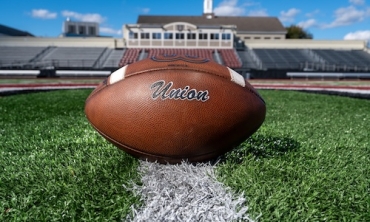Union to launch a women’s flag football program in spring 2027

"Our students are engaged in research at a level that’s just not possible at many other institutions. We have facilities and equipment that are comparable to those at larger universities, such as our particle accelerator. But at those schools, the facilities are mostly controlled by graduate and post- doctoral students. Our undergrads are deeply involved in the operation of everything we have."
Chad Orzel, associate professor of physics,
Combine your STEM program with majors and minors in the arts, humanities and social sciences.
Hands-on, faculty-mentored undergraduate research is at the heart of a Union education.
All year round, students work closely with their professors—in classrooms, labs, studios, archives and in the field—delving into topics that intrigue and challenge them. And for one day each May, the College suspends classes so that students can share their academic and creative interests and talents at the Steinmetz Symposium, a campus-wide celebration with peers, professors and families.
The symposium celebrates a culture of personal discovery that integrates coursework, faculty mentorship and peer collaboration to deepen students’ understanding of their subjects and themselves.
On campus and off, there are great ways to become involved in activities geared toward your interests.
Union students get a firsthand look at the culture of Silicon Valley while working for start-ups and other companies during this term away. The program combines an internship with a course in culture and entrepreneurship, which includes readings, field notes, and meetings with key employers and alumni in the area. About half of the students work in STEM-related fields. Most recently, participants have interned at the California Academy of Sciences, the Exploratorium, the software company Zendesk, a student loan refinancing start-up, and numerous nonprofits.
With Union's international programs, you'll experience another culture, challenge yourself academically and personally, and develop as a citizen of the world. Most programs are led by our own Union faculty, so you also will get to know your professors beyond the campus environment.
There are numerous student clubs and organizations that appeal to STEM majors and others with a love of science and technology. They range from student chapters of science and engineering societies to clubs devoted to health and medicine, environmental action, rocketry and space, beekeeping and more.
No matter what your STEM field, our campus environment is designed to spark your passion for exploration, discovery and reasoning in scientific and technical fields – and empower success in your future studies and career.
» USE a 1.1-MV tandem pelletron accelerator, 400-MHz nuclear magnetic resonance spectrometer, micro CT scanner and other sophisticated instrumentation, including equipment in the thermal science and fluid mechanics lab.
» VIEW the planets and gain a galaxy of knowledge by using the Union Observatory, which features a 20-inch Ritchey-Chretien telescope with SBIG CCD camera and a 7.5-foot radio telescope for research projects in observational and radio astronomy.
» DO cutting-edge work in tissue culture and molecular biology suites.
» WORK with robots and leverage a state-of- the-art motion capture system in the CRoCHET lab —the Collaborative Robotics and Computer-Human Empirical Testing Lab.
» EXPLORE sustainable building design and renewable energy systems in the Energy and Environmental Engineering Suite. Design, set up and monitor prototypes in the Rooftop Energy Research Lab.
» UNDERSTAND how the brain works, with studies in everything from neuroethology to the intricacies of cognitive processing, in the Center for Neuroscience.
» FABRICATE and tinker in our Makerspaces, interdisciplinary labs that support maker activities using digital and analog tools, including virtual reality technology, 3D printers and scanners, a laser cutter, CNC router, soldering kits and more.
» LEARN about how to acquire, analyze, interpret and visualize data in our Center for Data Analytics.
» STUDY the peptoid-mediated assembly of nanoparticles at fluid interfaces using the Langmuir trough.
Our emphasis on innovation, research, problem-solving and communications will set you up for success in graduate schools, fellowships and a wide range of careers.
GORDON GOULD '41 » Inventor of the laser; worked on the Manhattan Project, 1943-45; co-founded optical communications company Optelecom; elected to National Inventors Hall of Fame
BARUCH BLUMBERG '46 » Physician and scientist; discovered antigen for Hepatitis B; received Nobel Prize in medicine
ALFRED SOMMERS '63 » Ophthalmologist who discovered vitamin A vaccine to save millions from blindness; received the prestigious Albert Lasker Award for Clinical Medical Research
RICH TEMPLETON '80 » Chairman, president and CEO of Texas Instruments; electrical engineer and global leader in semi-conductor design and manufacturing; vigorous STEM education advocate
SUE GOLDIE '84 » Physician and MacArthur Fellow who developed models to evaluate public health impact of HIV, hepatitis and HPV
MELISSA STEWART '90 » Award-winning author of National Geographic Kids titles and other science books for children
SUSAN HULSE '92 » Medical director, Because Every Mother Matters, providing medical assistance to indigent women in Ethiopia
JULIA COLLIGNON '04 » Engineer and senior manager at Tesla's Renewable Energy Development
KAROLINA CIKOWSKA '07 » Founder of Girls Code Fun Foundation to inspire girls in Poland to pursue an education in technology
AJAY MAJOR '12 and ALEENA PAUL '12 » Medical residents and founding editors of In-Training, the premier online journal for the worldwide medical student community
MEGAN O’CONNOR '12 » Co-founder and CEO, Nth Cycle environmentally friendly electronics recycling firm; Department of Energy Innovation Crossroads Fellow; Forbes “30 Under 30” energy innovator
CHARLES MOORE '87 » Head and neck surgeon Grady Memorial Hospital, Atlanta